Amy: Now we have got water we can get the veg patch going? Any tips on what to plant Jude?
Me: Plant lots of love! Let me have a think I will message you tomorrow.
A message between Amy @wattleandtwine and I late Sunday night on Instagram. After years of drought and dust storms Amy and her farmer’s dam filled up practically overnight. Unbelievable and just so brilliant for them!
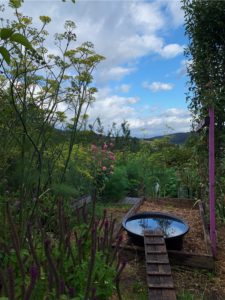
Honeybee the ducks bath emptied daily on the garden beds. I only started caring for ducks when Lil was old enough not to drown in the duck bath.
~ Plant lots of love ~
What we put energy into expands. The more love and care we give, the more something thrives.
In the garden think mulching heavily, it will suppress any rogue weeds that have been laying low until they get some water on them. The mulch will encourage the worms, feed the soil as it breaks down,
Lots of manure, use what you have got and lucky you if you live on a farm with livestock. When we lived at our previous property every couple of weeks Lil and I would get my shovel, the wheelbarrow and go poo-ing. Yeah, it does sounds terrible to anybody not in the know. Lil (between 3 to 5 yrs old) had a “special” red kids shovel (obviously called her poo-ing shovel, and it was a different colour to her sandpit shovels so she knew not to use it in her sandpit) and we would go into the paddock and collect dried up cow poo from Abby the gorgeous Murray Grey cow. We put the poo into our garden beds or compost bins.
Treat your garden beds to manure, rock minerals and lime before you plant (follow the instructions on the packets).
*Lime. While researching our family history Lil came across a statistical account dated 1793 written by my 6th Great Uncle where he advocates the use of lime and states how productivity and harvests have benefited since using it.
Feed your plants with liquid fertiliser every couple of weeks. I know some people make their own soaking weeds or chook poo in bins of water and I used to do this but when I had Lil I stopped, I just didn’t need one extra thing to worry about her drowning in.
Due to the scars on my hand I still don’t mix up weed or chook poo potions, it’s a preventative measure for me not getting my hand infected. Michael and Lil are talking about taking the liquid manure job on.
Apart from liquid seaweed solution we no longer use commercial products such as rose feeds or slow release plant feeds on our garden. Why? After years of using them the garden just didn’t seem as resilient and wasn’t thriving.
What would my great grandparents have used I thought, so we have returned to using more animal manure, mulching with thick biscuits of hay bought locally or sugar cane mulch, plus adding rock minerals and lime. What a difference, the garden is now abundant and back to thriving.
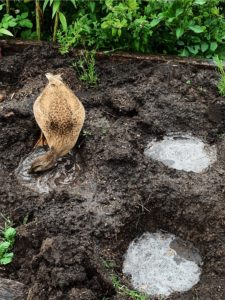
With the soil in the garden beds so dry, before we add the manure etc we have been digging holes & filling them with water to help the water penetrate into the soil. We refill the holes with water until the hole can hold the water, not soaking in straight away.
~ The bigger picture ~
With veggie gardening we are so used to thinking of traditional garden beds with vegetables planted in straight lines, fruit and vegetables that are quick growing for only one season, annual crops.
When you no longer primarily focus on only growing annual fruit and veggies the garden stops being so labour intensive, and it is no longer an endless money pit. (Where ever home is for you the local fruit and vegetable seasonal guides on the Gardening Australia website are a handy reference for those short term crops.)
Think about plating more perennial fruits and vegetables instead of annual fruit and veg.
Perennial crops last at least a couple of years in the ground (they will have larger/stronger root growth) be more productive, you will harvest more, as well as producing food for you they will attract bees, beneficial insects, provide habitat for frogs & ladybugs, shelter for your chooks. Old leaves and clippings can go in the compost, worm farm or fed to your chooks, so many benefits. It also means less work for you constantly planting, feeding & watering.
Suggestions: Chilli Tree (Capsicum frutescens), Perennial Rocket , Tasmanian Mountain Pepperberry (Tasmannia lanceolate) to
grow your own pepper instead of buying imported cracked black pepper.
When a fruit tree isn’t just a fruit tree blog post here
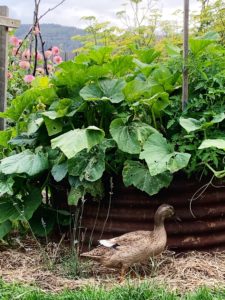
~ Plant for resilience ~
Bigger, more established plants are more resilient than cheaper tiny seedlings that after a day in the sun can collapse. In the long run the bigger plant is cheaper than constantly buying smaller plants that don’t survive or need a lot of fussing over and work.
I first saw this idea on a tv gardening show years ago and after doing trials in my own garden find this is the best way to plant something. (Note I don’t plant trees this way). Instead of digging a hole and putting your plant into the hole level with what it would have been in the pot, dig the hole deeper so the lowest branches are just above the earth. It helps the plant establish a bigger root ball, the plant is hardier during strong winds because there is more of it underground anchoring the plant, therefore more resilient.
Dig your hole, fill it with water, put your plant in the hole, backfill with soil. The water in the hole gives the root ball of the plant a good thorough soak through and helps it establish with less shock.
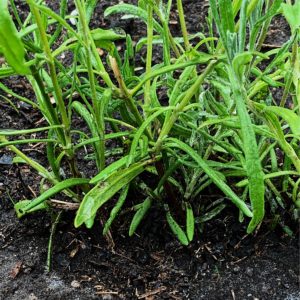
See how this young lavender is planted so deeply.
~ Plant for the bees ~
Around the boundary of your veggie patch/kitchen garden plant flowers.
Fruit and vegetables to nourish the body. Flowers to nourish the soul.
Can you care for native stingless bees in your area or honey bees?
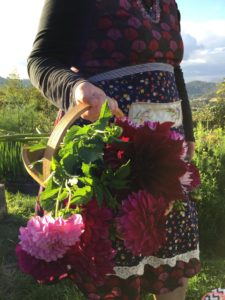
Plant what you love, I love picking flowers most days.
~ Plant a herb garden for cooking ~
Buy two of everything. Think abundance.
Instead of buying one rosemary plant buy two. Take cuttings from the first plant to establish more rosemary plants and while this plant is regrowing, take sprigs of rosemary from the second plant for your cooking. This works great for sage as well.
With Bay trees, harvest leaves from the inside branches to allow for good air circulation instead of taking leaves just from the tips of the branches until the tree gets well established, then you can alternate between taking inner branch leaves and leaves from the tips of branches. How we harvest and store bay leaves here
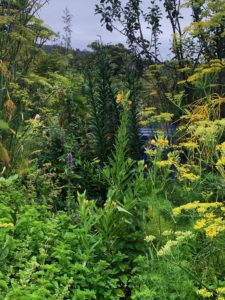
One of Lil’s herb gardens.
~ Plant herbs to make herbal tea ~
Lemon balm, lemon verbena, lavender, chamomile, peppermint, mint, lemon myrtle. What is your favourite tea? Could you mix your own loose leaf blends & make your own by growing some ingredients?
These plants could just be planted around the boundary of your veggie patch.
*Just keep flowers (that can be toxic) away from edible plants. When Michael collected the lettuce one night before dinner we did end up with foxglove leaves on our plate. Easy mistake.
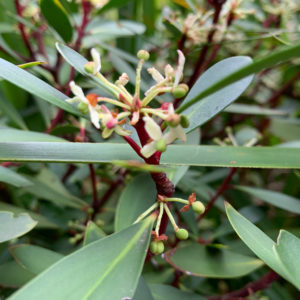
Tasmanian Mountain pepper berry ripening.
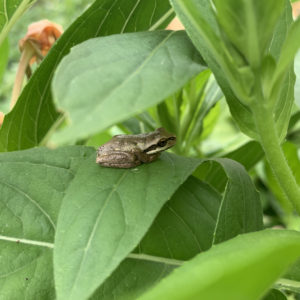
Spotted in the garden this week sheltering in the evening primrose leaves that self seeded amongst the bush beans.
~ Plant fruit trees in your chook pen yard ~
If you can, or if you need to, at least double the size of your chook pen yard and plant as many fruit trees as you can in there. The trees don’t have to be in traditional rows. In our big hen house yard we have the fruit trees dotted around the fence line and a few in the middle of the yard. With the extremes in weather, your chooks will have plenty of shade during the hot months, fertilise your trees for you, keep the pests and diseases down, eat the windfall fruit. The chooks are doing the work instead of you.
You can get all the tips and tricks I found work the best to stop chooks scratching everything up here.
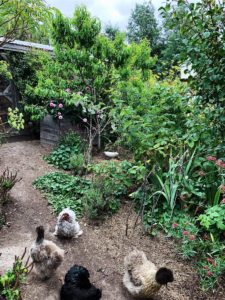
The big Hen House yard. Planted with fruit trees, herbs, flowers to attract bees & beneficial insects.
~ Plant an abundance ~
All fruit and vegetables have good and bad years depending on the growing season. Plant different varieties of everything, and plant them in different parts of the garden, that way pests and diseases can’t attack the one variety on mass at once, and you can harvest fruit and veg varieties at different times. eg. in our Quince Orchard we have 5 different varieties of quinces that we harvest over 8 weeks.
It won’t be long before bare rooted fruit trees are available in the nursery’s, priced at about $20 instead of buying them out of season for double or triple the price. At the dinner table start conversations about making a list of everyone’s favourite fruit trees to buy. When kids (and maybe a not as eager parent) feel ownership of something they care for it more, and it turns into a good fun family project.
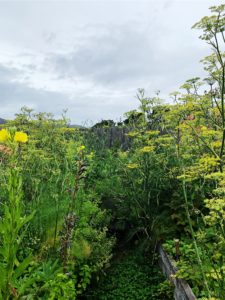
Strawberries, Alpine white strawberries, raspberries, cucumbers, beans, coriander, tomatoes, fennel, plus a variety of herbs are all growing in these garden beds. An apple & a quince tree at the back of the beds.
 ~ Plant for love ~
~ Plant for love ~
Plant for the memory of loved ones past and those who you hold nearest and dearest. I have my Nan’s favourite violets growing everywhere, hop’s growing in memory of my grandfather, Lil and Michael grow Flanders poppies in memory of Michael’s mum, I grow different roses and stocks that remind me of friends who live far away but who I hold close to my heart. The list goes on.
When friends or family come and stay we plant something. Long after the visit they are always asking “How is my plant going?”
We always plant trees when overseas guests visit, sometimes that tree will be the only tree they will ever plant in their entire life.

The Children’s Rose.
Five gardening tips:
1. Instead of buying toxic snail bait, use old saucers (I buy them for 20 cents at the op shop) and mix Vegemite and water in them. This is still Lil’s job, when she was little we had a special story, it was “mixing up a special drink for the slugs & snails for when they have a party, the slugs will love it so much they will drink too much and fall asleep”
Read: The yeast in the vegemite attracts the slugs & snails (saves buying beer) the slugs and snails drink the vegemite/water and then die. Happy plants. Happy gardeners.

Vegemite & water mixed together, the slugs & snails love it!
2. Each year buy a bulk order of something. The first year for us was fruit trees, the second year it was roses, the third year bulbs. You can read more about it here
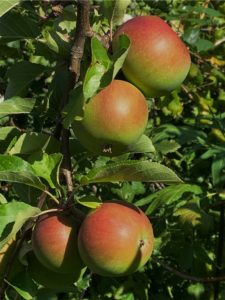
White Permain Heritage Apple tree. Beautiful cooked but also lovely eaten straight from the tree as well.
3. Plant your mint underneath your tap, the drips from the tap water aren’t wasted and mint loves moisture.
4. Don’t be too quick to weed, little veggie seedlings self seeding can save so much money.
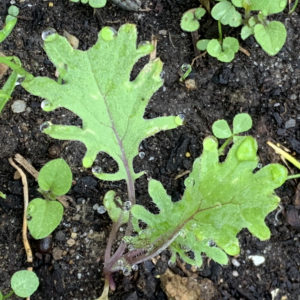
Self seeded Kale. If I had weeded too soon I would have lost it.
5. Always, always give your kids their own prime little garden spot and let them choose something for their garden each time you are at the nursery. It instills a love of gardening, good life skills.
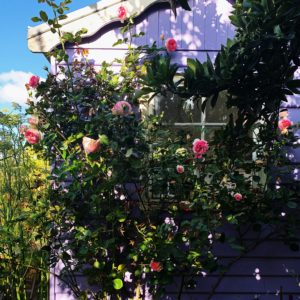
Lil’s garden. Her plant combinations have changed over the years.
Time.
That time between the work day finishing and dinnertime is when we do the most in the garden. Lil or I try to have dinner already prepared. Family time in the garden, unwinding from the day. A little over an hour each day the time goes fast, by the end of the week it adds up to a full days work. This is how we get things done. It is work, but rewarding, relaxing work, and not joking, some of those times have made our best family memories.
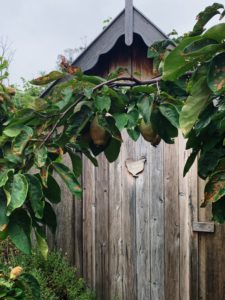
Just like buying clothes make sure your garden is the right fit for you and you plant only what you love to eat and what you eat the most of. If at anytime it feels like you have taken on too much, just put a thick layer of mulch on what you aren’t using. The worms will keep working for you and getting the bed ready for when you are ready again to plant.
Happy Gardening,
Sending Light & Love,
Jude x
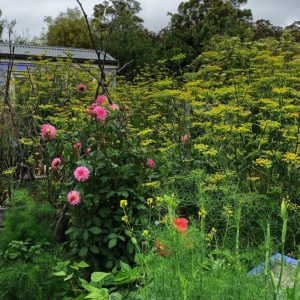
Planting fruit & veg after the drought.
February 10, 2020
comments
share